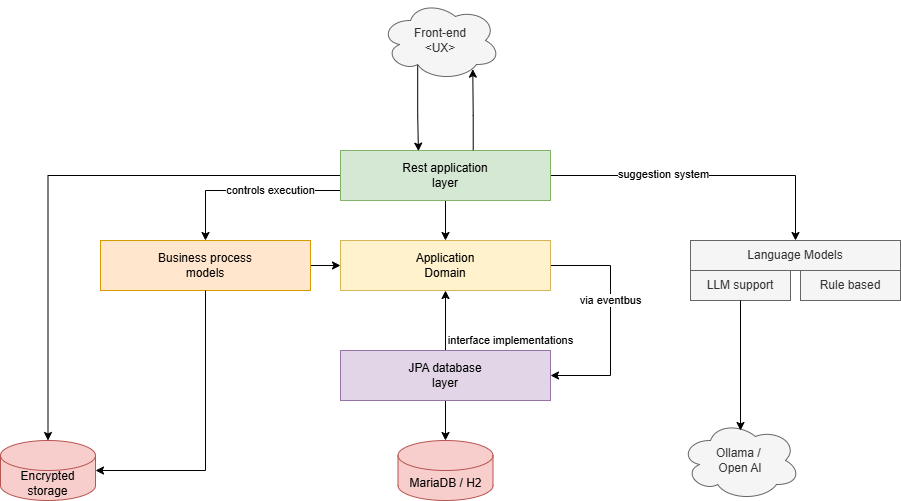The backend design for Pledger.io
The REST-api is the main component of the application. This part of Pledger.io is build using the following tooling:
-
Gradle, used as the build tool.
-
Micronaut framework, used as the DI and API framework.
-
Camunda BPM, used to automate workflows inside Pledger.io.
-
LangChain4j, used as the engine to interact with Vector stores and LLM implementations.
Internal design
The REST-api is designed to be a stateless application. Inside this part of the application, several layers are recognized:
-
The
REST-api layer, which is the entry point for all requests. -
The
Application domainlayer, which contains the business logic. -
The
Business Process layer, which contains the workflow logic and is based on Camunda BPM. -
The
JPA database layer, which contains the database access logic.

In this design the Application domain layer does not directly communicate with any of the other layers.
If an action occurs on any of the entities in this layer, an event is published on the internal event bus.
This event bus is provided by Micronaut and is only accessible inside the application.
Rest application layer
Serves as the primary interface to the application, providing well-designed REST API endpoints for client applications. It handles all aspects of HTTP requests and responses, including serialization, content negotiation, and error handling. The module implements robust API security mechanisms and thorough validation to ensure that all incoming data meets the application’s requirements.
Domain module
Represents the heart of the business functionality, defining the comprehensive domain model and encapsulating all business logic. This module contains detailed entity definitions that model real-world concepts and implement the business rules that govern system behavior. It provides well-defined service interfaces for all business operations, creating a clear API for other modules to interact with the domain.
Business process models
Implements comprehensive business process management functionality using industry standards. It leverages Camunda, a powerful BPM platform, for reliable process execution. This module allows the application to define and execute complex business processes with proper state management, task assignment, and process monitoring.
Language models
Implements advanced machine learning capabilities that enhance the application’s intelligence. It provides transaction classification and suggestion features that help users organize and understand their financial data. The module includes both rule-based learning for deterministic patterns and LLM-based (Large Language Model) learning capabilities for more complex, natural language processing tasks.
JPA database layer
Handles all aspects of data persistence using the Java Persistence API (JPA). It provides concrete repository implementations for all domain entities, abstracting the details of data storage and retrieval. This module efficiently handles database operations and transaction management, ensuring data integrity and consistency throughout the application.
